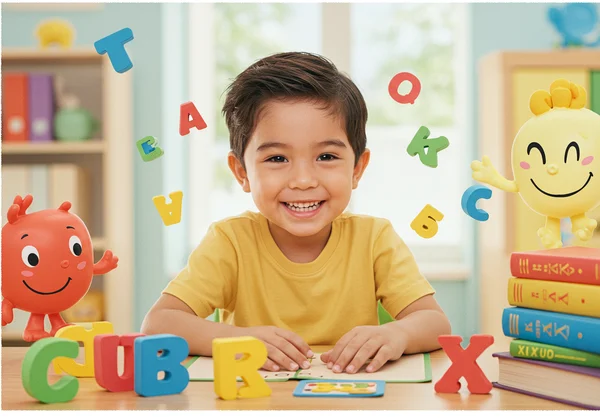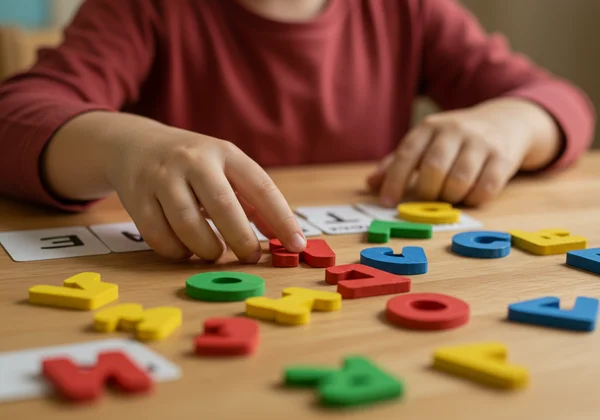Fun Dyslexia Reading Games for Kids: Home Support & Dyslexia Screening
Is your child struggling with reading, and you're searching for engaging ways to help them at home? It can be disheartening to watch your bright, creative child get frustrated with words that seem to jumble on the page. You're not alone, and the solution might be more playful than you think. Discover how fun, play-based dyslexia reading games can transform their learning experience, build essential skills, and boost their confidence. How to help a child with dyslexia? The journey begins by making reading mastery an enjoyable adventure for both of you, and understanding their unique needs is a great first step.
These playful activities aren't just for children showing early signs of dyslexia; they offer a powerful boost for any young reader, transforming potential struggles into triumphs. By turning skill-building into a game, you remove the pressure and anxiety that can often surround reading homework. You create a positive, supportive environment where your child feels safe to try, make mistakes, and ultimately, succeed. Let's explore some simple yet powerful reading activities you can start using today.

Boost Phonetic Awareness & Decoding Skills
For a child to truly unlock the world of reading, they first need to grasp a crucial concept: that words are built from individual sounds, known as phonemes. This skill, called phonological awareness, is a critical area where many children with dyslexia need extra support. Decoding—the next step of connecting sounds to letters—can be made intuitive and fun with the right phonics games for dyslexia.

Engaging Games for Sound Recognition & Blending
Mastering sound recognition is the bedrock of reading. These games help your child's brain tune into the sounds within language, a skill that must be solid before they can effectively tackle written words.
- Sound Scavenger Hunt: Say a sound, like the "b" sound. Have your child run around the house to find objects that start with that sound (ball, book, bed). This connects auditory processing with physical movement, reinforcing the concept in a memorable way.
- "I Spy" with Sounds: A classic game with a phonetic twist. Instead of saying "I spy with my little eye something that is green," say "I spy with my little eye something that begins with the sound /s/." This isolates the initial sound, helping your child hear the distinct phonetic units in words.
- Rhyming Pairs: Collect a few small toys or picture cards. Lay them out and ask your child to find the two that rhyme (e.g., car and star, cat and hat). Rhyming is a key element of phonological awareness, and this hands-on approach makes it a concrete task.
Playful Activities to Master Letter Sounds & Decoding
Once your child is more comfortable with hearing sounds, you can connect them to the letters that represent them. The goal here is to make the abstract concept of letter sounds tangible and interactive. These reading activities for dyslexia help bridge that crucial gap.
- Mystery Letter Bag: Place a single plastic or wooden letter in an opaque bag. Have your child reach in, feel the shape of the letter without looking, and guess what it is. Once they guess, they can take it out and say the sound it makes. This multisensory approach strengthens letter recognition.
- Word Family Sliders: Write a word ending (like "-at") on a notecard. On a separate strip of paper, write a series of beginning letters (c, h, m, b, s). Slide the strip through slits cut in the notecard so your child can create and read new words (cat, hat, mat). This visually demonstrates how changing one sound changes the whole word.
- Shaving Cream Words: For a truly sensory experience, spray a layer of shaving cream on a tray. Call out a simple three-letter word and have your child use their finger to spell it out. The tactile feedback can create strong neural pathways for spelling and reading.
Enhance Reading Fluency & Comprehension at Home
Once a child can decode words, the next goal is to do it smoothly and with understanding. Fluency is the ability to read with speed, accuracy, and proper expression. Comprehension is, of course, understanding the meaning of what has been read. Without these skills, reading can feel like a slow, laborious chore. Before diving into these games, if you're wondering about your child's specific challenges, an online dyslexia test can provide valuable insights.

Fun Strategies for Building Reading Speed & Accuracy
Improving reading speed and accuracy takes practice, but it doesn't have to be boring. The key is to build momentum and confidence through low-pressure repetition.
- Partner Reading: Take turns reading a book aloud. You read a page, then your child reads a page. This gives them a model of fluent reading and a short break, making longer texts less intimidating.
- Echo Reading: You read a sentence with good expression, and your child immediately repeats it, trying to mimic your tone and pace. This helps them learn the rhythm and flow of natural language.
- Highlight a Word: Pick a common "sight word" your child struggles with (e.g., "they," "was," "where"). As you read a book together, have them tap or highlight the word every time it appears. This targeted repetition can help move tricky sight words into their long-term memory.
Interactive Ways to Improve Story Understanding
True reading is thinking. These activities encourage your child to engage with the text, ask questions, and make connections, which are all vital reading comprehension skills.
- Be the Detective: As you read, pause and ask "detective questions": "Who is the main character?", "Where is this happening?", "What do you think will happen next?". This teaches them to actively search for meaning while they read.
- Draw the Scene: After reading a descriptive paragraph or a chapter, ask your child to draw what they just read. This non-verbal way of expressing understanding is perfect for visual thinkers and helps solidify the story's events in their mind.
- Act It Out: Choose a simple scene from a book and act it out together. Assigning characters and speaking the dialogue brings the story to life, making the plot and character motivations much easier to grasp.
Integrating Dyslexia Reading Activities into Daily Life
The most effective home support for dyslexia is consistent, positive, and woven into your family's routine. You don't need to set aside hours every day. Short, joyful bursts of activity are often more effective than long, draining study sessions. The goal is to nurture a love of language and stories, not to create a battleground over books.
Making Learning Multisensory & Enjoyable
Children with dyslexia often learn best when information is presented through multiple senses at once. This is the core principle of multisensory learning. It means engaging sight, sound, touch, and even movement to build stronger connections in the brain.

Think beyond flashcards. Have your child form letters with play-doh, trace them in a sand tray, or jump on letter mats placed on the floor to spell out a word. When you combine saying the letter sound, seeing its shape, and feeling its form, you give their brain three different ways to store and retrieve that information. The more senses you involve, the stickier the learning becomes.
Tips for Consistent, Low-Pressure Practice
Consistency is more important than intensity. Ten minutes of a fun phonics game every day is far more beneficial than a stressful hour-long session once a week. Schedule "game time" into your routine, perhaps after school or before bed.
Most importantly, keep the atmosphere light and positive. Praise your child's effort, not just their accuracy. Celebrate small victories, like successfully sounding out a tough word or remembering a rhyming pair. When your child associates reading practice with fun, encouragement, and quality time with you, their motivation and confidence will soar. If you need a starting point to understand their specific needs, you can take our free test.
Empowering Your Child's Reading Journey
Turning reading support into a series of fun games can fundamentally change your child's relationship with books and learning. You are not just teaching them to decode words; you are building their confidence, strengthening your bond, and showing them that they are capable of overcoming challenges. Every rhyming game played and every story acted out is a step toward unlocking their full potential.
Remember, the most powerful tool you have is your understanding. Recognizing your child's unique learning profile is the key to providing the right support. To gain clearer insight into their cognitive strengths and potential challenges, consider starting with a professional screening tool. A free dyslexia screening can provide you with a personalized report and actionable next steps, empowering you to make informed decisions for your child's future.
Frequently Asked Questions About Supporting Dyslexic Readers
How can I best help my child with dyslexia at home?
The best way to help is to create a positive, low-pressure learning environment. Focus on fun, multisensory activities like the games mentioned above. Read aloud to them regularly to foster a love of stories, praise their effort consistently, and work closely with their teachers to ensure you are supporting their school curriculum.
When should I consider a dyslexia screening test for my child?
If you notice your child is significantly behind their peers in reading, avoids reading activities, has trouble with rhyming or sounding out words, or expresses frustration and low self-esteem related to schoolwork, it may be time. A dyslexia screening test is a proactive first step to identify potential risks and understand if further evaluation is needed. It can give you the clarity you need to seek the right support.
Are these reading games suitable for all ages?
The games described here are specifically designed for children in the 5-12 age range, when foundational reading skills are being developed. While the principles of multisensory, play-based learning are beneficial for all ages, older teens and adults may require more advanced strategies focused on vocabulary, reading speed, and compensatory tools.
What's the difference between a dyslexia screening and a formal diagnosis?
This is a crucial distinction. An online screening, like the check for dyslexia tool we offer, is designed to identify potential signs and risk factors for dyslexia. It's a quick, accessible first step. A formal diagnosis, however, is a comprehensive evaluation conducted by a qualified professional, like an educational psychologist. It provides a definitive clinical diagnosis and is often required for accommodations in school. Our screening helps you decide if pursuing a formal diagnosis is a necessary next step.